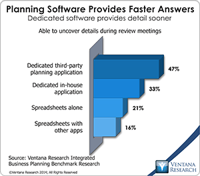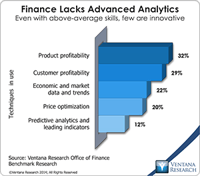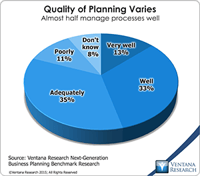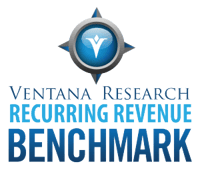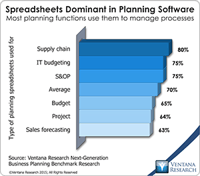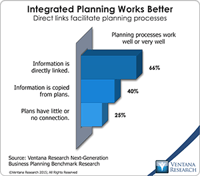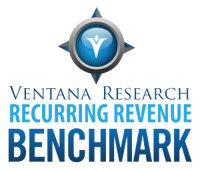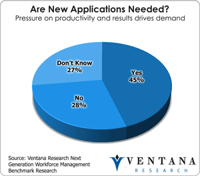Adaptive Insights held its annual user group meeting recently. A theme sounded in several keynote sessions was the importance of finance departments playing a more strategic role in their companies. Some participating customers described how they have evolved their planning process from being designed mainly to meet the needs of the finance department into a useful tool for managing the entire business. Their path took them from doing basic financial budgeting to planning focused on improving...
Read More
Topics:
Planning,
Operational Performance Management (OPM),
Reporting,
Budgeting,
Human Capital,
Analytics,
Business Analytics,
Business Collaboration,
Business Performance Management (BPM),
Business Planning,
Customer Performance Management (CPM),
Financial Performance Management (FPM),
Sales Performance Management (SPM),
Supply Chain,
Supply Chain Performance Management (SCPM),
Workforce Performance Management (WPM),
Demand Planning,
Integrated Business Planning,
Project Planning
There’s a long history of companies not paying close enough attention to the contractual elements of acquiring software. Today, this extends into the world of cloud computing. Many companies are choosing to acquire software services through cloud-based providers and increasingly rely on access to cloud-based data, as is shown by our forthcoming benchmark research, in which a large majority of participating companies said that having access to data in the cloud is important or very important. As...
Read More
Topics:
SaaS,
Operational Performance Management (OPM),
contract,
e-discovery,
Cloud Computing,
Governance, Risk & Compliance (GRC),
Business Performance Management (BPM),
Customer Performance Management (CPM),
Financial Performance Management (FPM),
Sales Performance Management (SPM),
Supply Chain Performance Management (SCPM),
Workforce Performance Management (WPM)
Managing prices has always been an activity of keen interest to businesses, but it has become even more critical to do it well. Over the past decade many companies have found their ability to raise prices has been constrained by intense competition resulting from Internet commerce, global competition and other factors. One tool for dealing with this pressure is price and revenue optimization (PRO), an analytic methodology that calculates how demand varies at different price levels and then uses...
Read More
Topics:
Big Data,
Performance Management,
Predictive Analytics,
Sales,
Office of Finance,
Operational Performance Management (OPM),
Analytics,
Business Analytics,
Business Performance Management (BPM),
Financial Performance Management (FPM),
Sales Performance Management (SPM),
analytical application,
Price Optimization
It’s stating the obvious to say that how well executives manage planning processes has a big impact on how well a business unit or company plans. However, one significant source of the value of our benchmark research is that it establishes hard evidence – the numbers – that transforms mere assertions into proof points. This is particularly important when people within an organization want to improve a process. Change management is facilitated by providing senior executives with facts to back up...
Read More
Topics:
Big Data,
Predictive Analytics,
Operational Performance Management (OPM),
Human Capital,
Business Analytics,
Cloud Computing,
Business Performance Management (BPM),
Customer Performance Management (CPM),
Financial Performance Management (FPM),
Sales Performance Management (SPM),
Supply Chain,
Supply Chain Performance Management (SCPM),
S&OP
Read More
Topics:
SaaS,
Customer Experience,
NetSuite,
Office of Finance,
Operational Performance Management (OPM),
Recurring Revenue,
Zuora,
Cloud Computing,
Customer Service,
Business Performance Management (BPM),
Customer Performance Management (CPM),
Financial Performance Management (FPM),
Sales Performance Management (SPM),
billing software,
Intacct
In our benchmark research at least half of participants that use spreadsheets to support a business process routinely say that these tools make it difficult for them to do their job. Yet spreadsheets continue to dominate in a range of business functions and processes. For example, our recent next-generation business planning research finds that this is the most common software used for performing 11 of the most common types of planning. At the heart of the problem is a disconnect between what...
Read More
Topics:
Planning,
ERP,
Forecast,
GRC,
Office of Finance,
Operational Performance Management (OPM),
Reporting,
closing,
dashboard,
enterprise spreadsheet,
Excel,
Analytics,
Business Analytics,
Business Collaboration,
Business Intelligence,
Business Performance Management (BPM),
Customer Performance Management (CPM),
Data,
Financial Performance Management (FPM),
Risk,
Sales Performance Management (SPM),
Supply Chain Performance Management (SCPM),
application,
benchmark,
Financial Performance Management
Ventana Research recently released the results of our Next-Generation Business Planning benchmark research. Business planning encompasses all of the forward-looking activities in which companies routinely engage. The research examined 11 of the most common types of enterprise planning: capital, demand, marketing, project, sales and operations, strategic, supply chain and workforce planning, as well as sales forecasting and corporate and IT budgeting. We also aggregated the results to draw...
Read More
Topics:
Big Data,
Planning,
Predictive Analytics,
Sales,
Social Media,
Human Capital Management,
Marketing,
Office of Finance,
Operational Performance Management (OPM),
Reporting,
Budgeting,
Controller,
Business Analytics,
Cloud Computing,
In-memory,
Business Performance Management (BPM),
CFO,
Customer Performance Management (CPM),
Financial Performance Management (FPM),
Sales Performance Management (SPM),
Supply Chain,
Workforce Performance Management (WPM),
capital spending,
demand management,
Financial Performance Management,
financial reporting,
FPM,
Integrated Business Planning,
S&OP
Recurring revenue is a term applied to business models that involve three types of selling and billing structures: a one-time transaction plus a periodic service charge; subscription-based services involving periodic charges; or a contractual relationship that charges periodically for goods and services. Telecommunications was the first major industry to use it, but recently the model has gained popularity in others. It is a major trend in information technology as an increasing number of...
Read More
Topics:
SaaS,
Customer Experience,
NetSuite,
Office of Finance,
Operational Performance Management (OPM),
Recurring Revenue,
Zuora,
Cloud Computing,
Customer Service,
Business Performance Management (BPM),
Customer Performance Management (CPM),
Financial Performance Management (FPM),
Sales Performance Management (SPM),
billing software,
Intacct
Business planning includes all of the forward-looking activities in which companies routinely engage. Companies do a great deal of planning. They plan sales and determine what and how they will produce products or deliver services. They plan the head count they’ll need and how to organize distribution and their supply chain. They also produce a budget, which is a financial plan. The purpose of planning is to be successful. Planning is defined as the process of creating a detailed formulation of...
Read More
Topics:
Big Data,
Planning,
Predictive Analytics,
Marketing,
Office of Finance,
Operational Performance Management (OPM),
Reporting,
Budgeting,
Human Capital,
Sales and Forecasting,
Analytics,
Business Analytics,
Business Collaboration,
Business Performance Management (BPM),
Business Planning,
Customer Performance Management (CPM),
Financial Performance Management (FPM),
Sales Performance Management (SPM),
Supply Chain,
Supply Chain Performance Management (SCPM),
Demand Planning,
Integrated Business Planning,
Project Planning,
S&OP
A company’s enterprise resource planning (ERP) system is one of the pillars of its record-keeping and process management architecture and is central to many of its critical functions. It is the heart of its accounting and financial record-keeping processes. In manufacturing and distribution, ERP manages inventory and some elements of logistics. Companies also may use it to handle core human resources record-keeping and to store product and customer master data. Often, companies bolt other...
Read More
Topics:
ERP,
Office of Finance,
Operational Performance Management (OPM),
Analytics,
CIO,
Business Performance Management (BPM),
CFO,
Customer Performance Management (CPM),
Data,
Financial Performance Management (FPM),
HR,
Sales Performance Management (SPM),
Supply Chain Performance Management (SCPM),
Workforce Performance Management (WPM)
